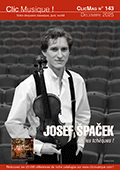 Nous avons précédemment présenté le polymathe italien, ingénieur, mathématicien, géographe, professeur de géographie, flûtiste et compositeur, qu’était Luigi Hughes (1836-1913). Cent-quarante-cinq œuvres variées, toutes dotées d’un numéro d’opus, et une cinquantaine de compositions sacrées sous forme manuscrite constituent son catalogue, parmi lequel les études pour flûte Opus 15, 32, 50, 75, 101 et 143, ainsi que le recueil "La scuola del flauto" op. 51 ont depuis longtemps retenu l’attention des flûtistes débutants et confirmés. Les cinq paraphrases présentées ici par l’éloquent Domenico Testaì avec une flûte traversière romantique à huit clefs et Ninni Spina sur un piano que l’on devine des années 1850, offrent un parfait panorama des talents et des limites artistiques de Hugues, qui excelle dans le genre restreint de la musique de salon. Les quatre opéras que Verdi composa entre 1850 (Rigoletto), 1867 (Don Carlos), 1858 (Un ballo in maschera) et 1870 (Aïda) sont pour Hughes l’occasion de proposer des traversées de leurs airs les plus connus, équilibrant exactement les parts de la notoriété musicale reconnue dans le cadre des salons bourgeois italiens de son époque et de la virtuosité requise par moment du flûtiste comme de son accompagnateur. Certains passage, notamment cantabile, sont effectivement à la portée d’un honorable amateur, tandis que d’autres, soutenus par une égale virtuosité de l’accompagnement, sollicitent une expertise instrumentale que l’on ne peut trouver que chez des flûtistes et pianistes professionnels. On ne cherchera donc pas ici l’approfondissement de l’art opératique de Verdi, ni l’expression d’un génie compositionnel propre à Hughes, mais on découvrira des pages joliment troussées pour le plaisir, que les interprètes distillent avec charme et aisance. Une remarque, toutefois, même compte tenu du caractère historique des instruments employés dans cet enregistrement, la prise de son étouffée dessert l’intérêt pourtant réel de ces découvertes. (Jacques-Philippe Saint-Gerand)  Besides being an engineer, a mathematician and a professor of geography, Luigi Hugues was also a flutist, a composer and an esteemed exponent of the nineteenth-century musical genre called Salon Musik. Born in 1836, he started and pursued his musical education together with his brother Felice. Both studied the flute and accompaniment piano; Luigi also proceeded with the study of composition. As we have already pointed out, music was not his only interest. He was also an eminent professor of geography and a scholar in that field. In 1859 he was a teacher at the Istituto Tecnico “Lerdi” of Casale Monferrato, and from 1875 onwards he was appointed professor of geography at the Regia Università of Turin. At the same time, in the years between 1863 and 1875 he was director of the Civica Scuola di Musica, a member of the board of directors of the Teatro Municipale, the conductor of the Corpo di Musica della Guardia Nazionale of Casale Monferrato, the organiser of the concerts of the Accademia Filarmonica of Casale Monferrato, and an organist first in the Chiesa di Santo Stefano of Casale, then in the Duomo of that city. Hugues, as previously stated, composed works of the Salon Musik genre: pieces that were suitable for everyday use and could be appreciated by a vast public, but at the same time were unmistakably characterised by didactic features. A careful analysis of his music, moreover, reveals a conscious, intentional use of the virtuosic style that was in vogue in the nineteenth century and was greatly loved by the public of concert halls: this feature is particularly noticeable in all the variations on operatic themes written for one or two flutes and piano accompaniment.
 |
